The Power of Belief – Altars and Altar Objects
PRIMITIVE - Friday, December 09, 2016By Glen Joffe
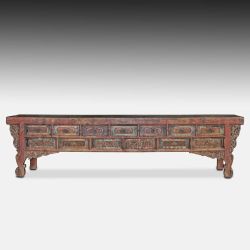 |
|
In a world where everything is in motion, nothing can remain unchanged. Civilizations rise and fall, religions flourish and wane, and leaders emerge and fade. Yet, in comparison it seems some basic human characteristics have hardly changed over the vast expanse of time. One such characteristic is our ability to feel and express complex emotions. Another is our capacity for imagination and conceptualizing dreams. There is also one more characteristic demanding mention - our unfailing, conscious belief system. Humans have always expressed belief in one thing or another since the birth of language – love, ideology, magic, the supernatural, and especially religion. In regard to religious beliefs they built churches, mosques, temples and other abodes to house their beliefs; and always, at the center of those places was the altar.
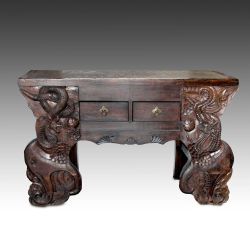 |
|
The purpose of the altar in addition to its physical shape and characteristics may vary religion by religion. For example, in Christianity the altar is often a table that represents a place of sacrifice or communion. It can be simple or elaborate; but it is a table nonetheless. On the other hand, in the East, altars can be miniature architectural structures, complete homes for honored ancestors. In Chinese Taoism, this type of altar is a place where both deities and ancestors are worshipped and reside. Also, in China another popular altar form is a table used to hold tablets inscribed with the names of ancestors as well as offerings of food and drink. Appropriately, it is called the altar table. In contrast, Hindu altars in India can be found in every temple as well as just about every individual home. They may vary in size and grandeur, but they always offer a sacred space graciously adorned with images of gods and goddesses. Finally, in Africa, altars are usually not even considered furniture, but instead, designated areas where sacred activities take place.
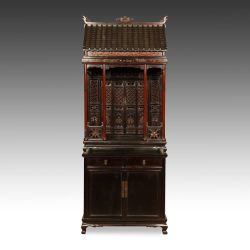 |
|
As diverse as altars may be, the fundamental concept driving their creation is surprisingly universal. Stated simply, the altar is a sacred space where the living world touches the divine. It is a place where the beliefs of people allow them to communicate and interact with deities and beings from the unseen world; yet, altars do not have to be overtly religious. Flowers placed at a site of a fatal accident or portraits of deceased family members placed lovingly on a living room table can equally be seen as altars. At its core then, an altar is any ordinary space made extraordinary by the strength of our beliefs. Yet, superseding the collectability of altars are the objects placed upon, within or nearby them.
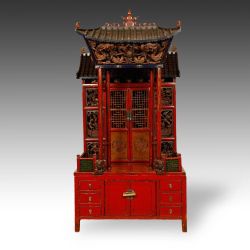 |
|
In India, Hindu altars are often dedicated to one main family deity, whose murti or statue is placed at the center. Nevertheless, images and statues of many other deities can also be presented. Popular deities include Shiva and Vishnu, two of the supreme divinities in Hindusim representing the destroyer of all things evil and the preserver and protector of humankind. Another popular deity is the goddess Lakshmi, who is believed to bring material wealth, prosperity and blessings and is celebrated during Diwali, the festival of lights. Still another deity whose statue appears on many Hindu altars is Ganesh, the elephant headed god believed to be the remover of obstacles, patron of wisdom and the god of beginnings. In Hinduism, the murti is believed to embody the spirit of the deity. Being “seen” by the statue is synonymous with actually being seen by the deity. Consequently, statues placed and worshipped upon altars are treated with the utmost reverence and respect.
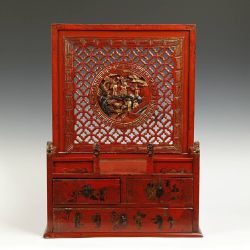 |
|
Objects that have been worshipped and made sacred often acquire a unique aura distinctly different from those simply made for commercial purposes. Nowhere can this be seen more clearly than in African art. Altars in Africa are not as architecturally elaborate as their Chinese or Indian counterparts. In fact, African altars are usually just cleared indoor or outdoor spaces, which place special emphasis on the people and objects operating within them. One of the most common types of objects found in African altars is the fetish. The term fetish was coined during the colonial period when Europeans first encountered man-made objects attributed with supernatural powers and used during religious rituals and ceremonies by a number of cultures in West Africa. The shape, size and materials used for creating fetishes vary greatly. Some are shaped anthropomorphically, some take on the appearance of animals, some are formed like vessels and still others represent parts of the anatomy, most commonly the phallus. Fetishes can even be completely amorphous.
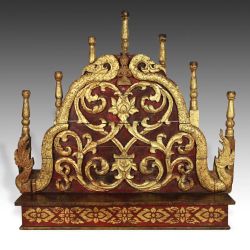 |
|
Oftentimes fetishes contain materials such as wood, leather, feathers, cowrie shells, nails, stones and sometimes hair or shards of bone. Fetishes were believed to contain potent and often dangerous powers. The creation and handling of fetish objects was therefore relegated to those initiated into priesthood or cults specifically assigned the management of the fetish. When not in use during rituals, the objects were hidden from public view and placed on altars to be given offerings designed to appease and feed the supernatural powers they were believed to contain. Authentic fetish figures are sought after by collectors worldwide. They almost always display a patina related to their use, evidence of the power given to them by the tribes.
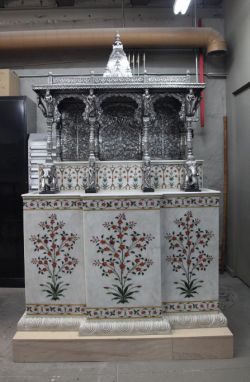 |
|
Generally speaking, the growing interest in altars and altar objects has spawned an interest in architectural styles related to this material. For example, at Primitive, visitors often find there is a certain attraction to the Buddha Room and other areas of the store where authentic altars and related objects can be found. These “rooms” have inspired the creation of related rooms and meditative spaces. Most recently, the restoration staff at Primitive proceeded on the modification and re-purposing of a stone architectural façade sheared off a building during the Great Gujarat Earthquake of 2001 in India. The façade, consisting of a doorway and two side walls, was approximately 40 feet long by eight feet high or three hundred and twenty square feet. The plan called for the wall to be converted into cladding for a room in a new construction home. The finished room required substantially more square footage than the original wall, so parts were re-designed, modified and then cast to expand the square footage. The finished room will be a temple or meditation room for the owners; and at one end of the room stands an altar known as a Ghar Mandir. Although the canopy top of the altar is original, Primitive created the bottom marble structure and then hand-painted motifs from the Taj Mahal on the marble.
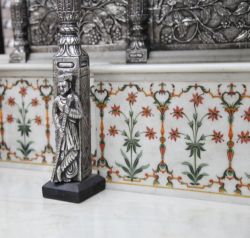 |
|
Altars, altar objects, and the spaces where they are found can create a sense of awe, wonder, magic and serenity. They blend art, culture, history, religion, architecture, interior design, and of course – belief – to create sacred space. In the process, they can also elevate our experience to the level of the divine.